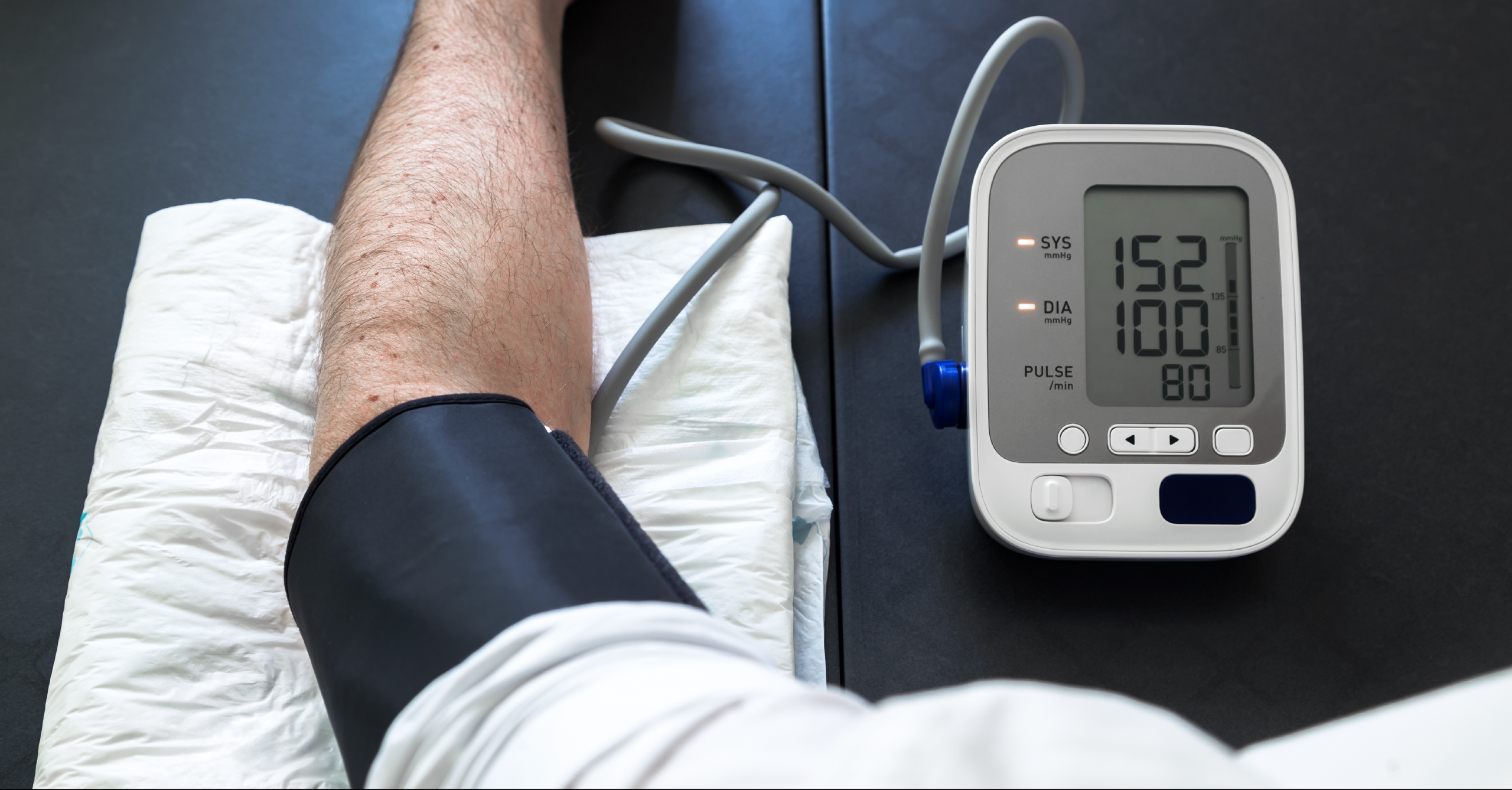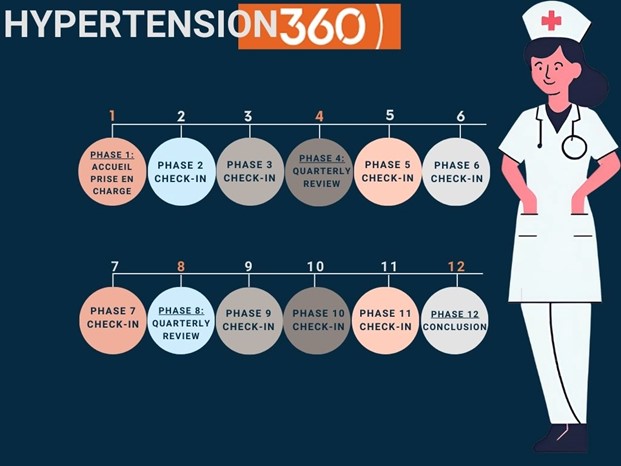Introducing Hypertension360: A Nurse-Led Program for Personalized Hypertension Care at Clinique Médicale 360

High blood pressure (hypertension) affects 1 in 4 Canadians and is a leading cause of heart attacks and strokes. Often overlooked, our daily habits significantly impact blood pressure. That’s why we’re excited to introduce Hypertension360, our new nurse-led program designed to empower patients in managing their hypertension. Through personalized follow-up, education, and customized action plans, this program addresses the modifiable factors that contribute to high blood pressure. Over the course of 12 months, patients will partner with skilled nurses to take control of their health and improve their hypertension. Studies show that programs like ours lead to meaningful reductions in blood pressure—and we’re confident Hypertension360 will do the same.
Did you know that:
- High blood pressure (or hypertension) affects 1 in 4 Canadians5;
- When undiagnosed and untreated, hypertension is one of the leading causes of heart attack and stroke5;
- Contrary to popular belief, blood pressure targets (such as “normal blood pressure”) are not a “one-size-fits-all” and oftentimes need to be individualized5.
What is blood pressure? How is it measured?
Blood pressure is the result of a complex interaction between the heart, blood vessels, nerves, and kidneys. When blood pressure is measured, it’s shown as a ratio (X/Y). The top number (X), called systolic pressure, is the highest pressure when the heart contracts to push blood through the body. The bottom number (Y), called diastolic pressure, is the lowest pressure when the blood vessels relax just before the heart pumps again. This measurement gives healthcare professionals important clues about the heart and blood vessels, helping them spot any potential health risks.
What is hypertension? How common is it?
Hypertension, also known as high blood pressure, is a condition where the force of the blood against the walls of the arteries is consistently too high. It’s typically diagnosed when blood pressure readings are 140/90 mmHg or higher on a regular basis, though specific thresholds may vary depending on age, medical history, and treatment guidelines5
It is estimated that nearly 45% of individuals aged 60 and above, and 27% of individuals aged 50-64 are afflicted by hypertension6. These numbers have substantially increased over the last decade, as many Canadians fail to realize and take control of the multitude of factors that contribute to this condition.
What causes hypertension?
There are different types of hypertension. Essential (primary) hypertension, the most common subtype, is most often the result of lifestyle, genetics and/or family history. Non-essential hypertension occurs because of another underlying medical conditions including for example kidney or adrenal disease, sleep apnea, rare endocrine tumors, pregnancy, thyroid disease or medication use2. Establishing the type of hypertension is important to determine the most appropriate intervention and/or course of treatment.
What are the symptoms and consequences of hypertension?
If hypertension remains untreated for too long, individuals may often experience hematuria (blood in urine), blurred vision, chest pain, nosebleeds, shortness of breath, dizziness, headaches, fatigue, and brain fog2. Recent research has also established significant links between uncontrolled hypertension and dementia 4, a condition that affects many but remains poorly understood.
Hypertension is often regarded as a “silent killer”, as signs and symptoms of this medical condition often remain unseen until it is too late. When undiagnosed and untreated, it is one of the leading causes of heart attack and stroke5
Why did we create Hypertension360?
At Clinique Médicale 360, we are committed to a preventive, 360-degree approach to health and wellness. We developed the Hypertension360 nurse-led program because we recognize the significant impact hypertension has had on our patients’ lives. While our patients receive exceptional care from skilled physicians, we believe that effectively managing hypertension requires more than just occasional visits. This program aligns perfectly with our vision of comprehensive, proactive healthcare, partnering patients with a nurse and empowering them to take control of their health and prevent complications through personalized, continuous care.
Inspired by research on the effectiveness of nurse-led programs, our physicians and nurses worked closely together to create a program tailored to each patient. Hypertension360 uses advanced blood pressure technology and follows the 2020 Canadian hypertension guidelines, which are based on a collection of evidence-based studies and serve as the foundation of our approach.
Why is Hypertension360 a nurse-led program?
Studies1,3, 5 show that nurse-led programs for managing high blood pressure led to significant improvements in health, including a noticeable drop in average blood pressure. This success was due to several key elements, such as educating patients, setting personal blood pressure goals, and providing guidance on lifestyle changes1. These programs helped patients feel informed, motivated, and better prepared to take control of their blood pressure and overall health. By focusing on education, regular check-ins, and coaching, they also built strong, trusting relationships between nurses and patients – an essential part of making these programs effective.
What does Hypertension360 consist of?
Our program is longitudinal and monitors patients monthly for a period of 12 consecutive months, as shown in the figure below.

Hypertension Program Overview
- Visit 1: Patients collaborate closely with their nurse partner to review their medical history and identify any health issues, such as diabetes or kidney disease, that could affect their blood pressure targets. This partnership allows the nurse to guide the patient through understanding their condition, analyzing their lifestyle habits, and providing essential educational resources. During the first visit, each patient also receives and is taught to use a 24-hour ambulatory blood pressure monitor (ABPM): a device that provides real-time feedback on blood pressure, helping to establish a baseline for personalized treatment. Readings from the ABPM are captured in a blood pressure chart that is shared with the nurse at every visit.
- Visits 4 and 8: By using the ABPM device again during visits 4 and 8, the patient and nurse can monitor progress and evaluate the efficiency of implemented strategies by measuring blood pressure.
- Visits 2 to 11: Throughout the program, patients meet with their nurse partner monthly to review in-office blood pressure readings and home blood pressure logs. These regular interactions provide ongoing support, with the nurse helping to identify and overcome new challenges and providing guidance on how to lower blood pressure.
- Visit 12: After 12 months, the program concludes with patients fully equipped with the skills and knowledge to manage their blood pressure independently and are empowered to continue their health journey either alone or through maintenance programs.
Empowerment and partnership
A key aspect of the program is personal empowerment, and from the start, patients are actively involved in managing and taking control of their health. The nurse collaborates closely with them, acting as a coach and partner to ensure that they have the knowledge, tools, and confidence to meet their personalized blood pressure goals.
If progress doesn’t meet targets, the nurse works with the patient to explore possible underlying causes, such as secondary hypertension. At any time, patients are welcome to consult with one of our physicians for further discussion.
While adjustments to medications may be needed, clear communication between the patient, nurse, and if necessary, a physician of the patient’s choice, ensures effective management. Nurses, though experts in hypertension, do not prescribe medications, but they can work alongside physicians to optimize treatment.
Patients who are members of Clinique Médicale 360 can share their results directly with their clinic physician, while non-members can consult physicians at our clinic or share the reports with their own healthcare provider.
How much does Hypertension360 cost?
- Price for clinic members: $612
- Price for non-members: $720
If I’m interested in Hypertension360, what do I do?
Now that you understand what hypertension is, ask yourselves the following questions:
- Do I have hypertension?
- Am I at risk?
- Do I know how to correctly identify and manage my risk factors?
- Is my hypertension currently well managed, and how can I make sure it is?
- Should I be followed?
If you have hypertension, and these questions resonate with you, we strongly feel that you may benefit from Hypertension360.
Don’t let your high blood pressure be “silent” Speak up and improve your health and well-being. Clinique Médicale 360 is here to help!
Contact us for more information or to book your first visit with your nurse partner


